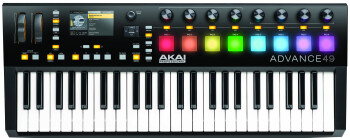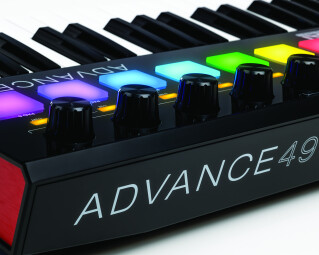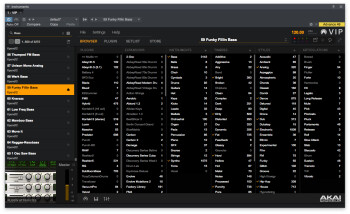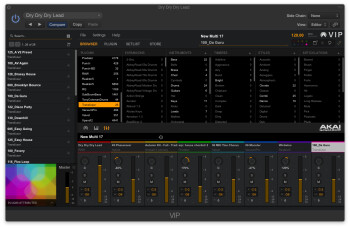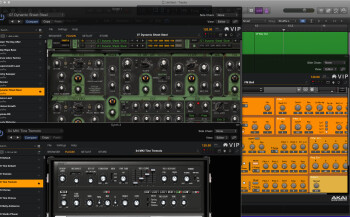Imagine a MIDI-controller keyboard that lets you seamlessly switch between virtual instruments from different manufacturers, keeps all your patches together in a single browser, and automatically maps controller information to its knobs and switches.
Imagine no more. That appealing vision has been brought to fruition by Akai Pro with the Advance series of controllers, which includes 25-, 49– and 61– key models. We reviewed the Advance 49, but other than the number of keys, the feature sets are the same.
The release of the Advance series appears to be a direct shot across the bow at Native Instruments’ Komplete Kontrol-S series. Both come with a lot of great instruments that are premapped for the keyboard’s controllers, but where they differ is that the Akai Advance is a more open system, whose software can host any VST instrument, whereas the NI keyboards’ control mapping and Komplete Broswer is designed exclusively for NI instruments, at least for now.
Advance tour
The keys on the Advance 49 are semi-weighted, velocity-sensitive and support Aftertouch. They have a substantial and firm feel, and are not spongy like some synth keys are. Controller wise, the keyboard includes eight large rotary encoder knobs, that are roughly an inch in diameter, much bigger than what you typically find on MIDI keyboards, and easy to grab in a live situation. Eight programmable switches are included, as are eight MPC-style pads (Akai makes the MPC, so these are the real thing) that light up in different colors depending on their function.
All the knobs, switches, and pads can alternate between four banks (using convenient front-panel buttons on the keyboard), giving you the potential of 32 programmable locations for each. On the upper left of the keyboard are substantially sized rubber-coated Mod and Pitch wheels.
A number of function buttons help you to access the numerous available features, and to top it off, 4×3" color display gives you excellent visual feedback.
The back panel has MIDI In and Out jacks, a USB/MIDI jack, a port for an optional 9V AC adapter (for situations where you’re not using a computer and thus don’t have USB bus power), 1/4” jacks for sustain and expression pedals, and an on/off switch.
Not only does Advance 49 offer some groundbreaking functionality, it also comes with a generous collection of instruments that includes Vacuum Pro, Loom, Hybrid 3, Xpand!2, Velvet and Transfuser from AIR, and Eighty Eight Ensemble by SONiVOX. These are all full versions. The Advance 49 seems like an even more substantial value when you factor in those instruments.
Very important software
What makes the Advance 49 a special system is its included companion software called VIP (Mac/PC). Installation of VIP (which stands for “Virtual Instrument Player”) and the included content is relatively easy. You can authorize it to run on a particular computer, or put your authorization onto an iLok key so you can move between computers easily. Most of the content installs from the main installer, but some additional content is available (for no charge) via the Store function in VIP.
VIP runs as a standalone application — which is what you’d most likely want for a live performance situation — or as a plug-in inside your DAW, which is more convenient for recording and production.
The Advance/VIP system supports VST plug-ins only. It doesn’t support VST3. When you first launch it, you tell it to scan your VST plug-ins folder. When it’s finished, it will have gathered information on what instruments you have and their associated patches. An additional step is required to bring in the patches of plug-ins that host different libraries within them, such as Native Instruments Kontakt.
Whether running standalone, or as a plug-in in your DAW, VIP acts as a host and integrated browser for your virtual instruments. From either VIP’s Browser window, or from the Advance keyboard itself (with a computer running VIP connected), you can access all your plug-ins and their patches from one central location. That’s an incredibly handy capability to have, especially if you have more than a few VIs in your collection. With all your patches together under a single browser, it’s much easier to search for a particular type of sound, or construct a layered sound from up to eight different patches using the Multi feature (which I’ll cover that a little later in this review).
In search of
When you select a plug-in in the browser, all of its patches show up in a window on the left-hand side of the GUI, where you can scroll through them. VIP gives you a couple of even-more-efficient ways to search in the Browser. One is a search window, where you can enter in an instrument name or keyword, and the list will instantly change to show all patches from your virtual synth collection that match the search term you entered.
To the right of the synth names in the browser, you’ll see a number that tells you how many patches from that synth matched the description, which is helpful. In addition to actual matches between the keyword and search term, VIP also finds patches that are related but don’t have the search term in their name.
If you want to get even more specific with your searches, the browser sports four columns of Tags (Instruments, Timbres, Styles, and Articulations). You can check the ones you’re interested in, and the Browser will update in real time, showing you patches from all your synths that match that combination of tags. It’s a great way to find sounds you want without having to step through each instrument’s entire preset collection. In other words, a big time saver.
VIP’s Browser functions are incredibly powerful, and, as far as I’m aware, no other software can do what it does.
Of multis and setlists
For the live keyboardist, especially, the Multi function of the Advance 49/VIP system is very powerful. You can have up to eight different patches in a Multi. You can layer them or split them. The latter is achieved via an easy-to-use graphic key-range control in the software, or a numeric version in the keyboard’s display. In VIP, you can drag and drop patches from the browser into any of the eight Multi slots. When in Multi mode, the eight pads on the keyboard become mute buttons (color coded for each Multi slot) and the eight switches become solo buttons. You can adjust volume, pan, and MIDI channel for each patch in a Multi, opening up a lot of possibilities.
Because VIP resides on your computer, there’s virtually no limit to how many Multis you can create and store. You could have one for each song in your live set, or one for each set. Or you could save great layered sounds you put together for recall when working in the studio. The possibilities are virtually limitless.
This audio example features a thickly layered sound made of eight different synth patches from a variety of instruments, created in Multi mode. There was no overdubbing, the complexity all comes from the motion of the various synth sounds.

One annoying aspect of creating Multis is that everytime you click on an instrument sound in the Browser, it automatically creates a new Multi, with that sound in the first slot, and you have to press the Multi History button to get back to the Multi you were working on.
The Setlist function is another handy capability of VIP. Open a new Setlist and you can drag and drop up to 127 patches into it. You can then save your Setlist for recall later. Setlists can be used to store patches for projects, patches that work well together, or patches that you want to store together for any reason. Nice.
In-app purchasing is all the rage these days, and if you click on VIP’s Store tab, you’ll be taken to a window where you can purchase and download Sonivox and AIR instruments and other collections without leaving the software.
In control
The Advance/VIP system’s handling of MIDI controllers is excellent. Open any patch and you’ll find controllers already mapped to the knobs and switches. Akai Pro spent a lot of time creating plug-in maps for a wide range of virtual instruments. If they haven’t provided an auto-mapped version, the VIP software automatically lays out controller assignments and tags the patches based on some sort of algorithmic calculation.
The key parameters were automatically mapped on most patches that I checked. When a parameter I wanted to control didn’t show up, VIPs Learn feature made it simple to assign it to one of the knobs or switches. You can then save the plug-in map with your changes, and recall it if you ever need to.
When you choose a patch or instrument in VIP, its GUI shows up within the software, and can be edited inside of VIPs window, or popped out to its own window, which is sometimes necessary to see all of its controls.
Key facts
Although you must be connected to a computer to use the VIP functions on Advance 49 (althogh you could use it as a standard MIDI controller keyboard without VIP), most of the VIP features can be accessed from the keyboard itself. The Browser, Multi, and Setlist functions are all accessible, although in many cases not as convenient, using the keyboard’s function, page up/down, and scroll controls. For instance, you can search your instruments and patches directly from the keyboard. However, it’s much slower going than when editing VIP on the computer, because you constantly have to skip between different menus.
The keyboard itself has a couple cool extras including an arpeggiator that has over a hundred different patterns ranging from standard up, down, and up/down to descending minor scales, augmented triads, chromatic glisses and lots more. You get 107 patterns all told. Wow.
Here’s a sound file that was created by holding one note down on the keyboard while stepping through an assortment of the arpeggiator’s patterns.

A Note-Repeat function is included, too, which is triggered by hitting any of the eight pads, and follows the tempo, which can be set to Internal or External on the keyboard.
The Keyboard’s transport controls are setup for DAW control, and several DAWs are listed in the Advance 49’s main window. According to Akai Pro, any DAW that supports external transport control can be controlled by an Advance-series keyboard, as long as all the various preference settings (mainly in the DAW) are correctly made.
I successfully setup transport control from the keyboard with both Ableton Live and Logic Pro X, using directions supplied by Akai Pro, which were substantially different for each DAW. These configurations also locked the tempo of the keyboard’s arpeggiator and note repeat functions to the DAW, which is handy, and not the case otherwise.
Going multiple
In case you were wondering, it is possible to run multiple instances of the VIP plug-in, should you wish. The only caveats are that if you change the MIDI notes or channels of the pads, they’ll change for all open instances, as will any deletions or additions of instruments or patches from the browser.
If you want the keyboard’s display to switch between the different instances you have open, so that you can make adjustments to a sound from the keyboard, you have to manually switch which instance the keyboard is addressing using the Main and left/right arrow buttons on the Advance 49.
Real world
I tested Advance 49 in a studio context. The physical keyboard’s keys, knobs, buttons, pads, and switches all responded well and seemed quite sturdy. The system worked smoothly most of the time, although very occasionally the keyboard or the VIP software seemed to lock up, and I had to restart one or the other, or both.
Considering VIP is in its first version (I tested version 1.0.350), that’s not terribly surprising. Overall, it seems pretty stable, and any glitchiness there is will likely be reduced as revisions are released.
Advance is a VIP
Akai Pro has hit a home run with Advance 49 ($499), which is far, far, more than just a MIDI controller. It’s ability to host your virtual instruments together in a single, searchable browser environment is brilliant, and sets it apart from any other product on the market. Other manufacturers have released automapping keyboards in the past, but none have achieved the versatility and flexibility of this Akai product. What’s great is that it will work with all of your VST VIs, no matter what brand.
The control mapping, Multi, Setlist and arpeggiator features are incredibly useful and well executed. The keyboard itself is loaded with control options, has a solid feel, and can even duplicate the browser and control functions of the VIP software (albeit less conveniently). Having both standalone- and plug-in-based DAW operation lets both live and studio users work in the most advantageous way. The selection of fully functional VIs that comes with the Advance 49 system is also impressive.
If you use virtual instruments, whether live or in the studio, you’ll make your musical life a lot easier, and more productive, with an Advance controller. This is a breakthrough product that will be much appreciated by keyboardists and recording musicians everywhere. As a result, we’ve given it an award for innovation.


